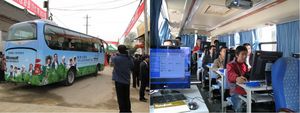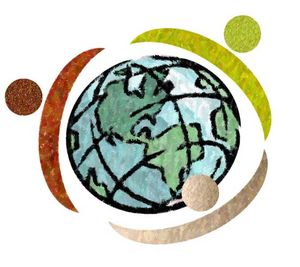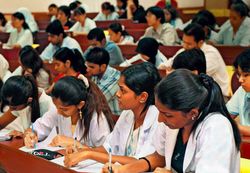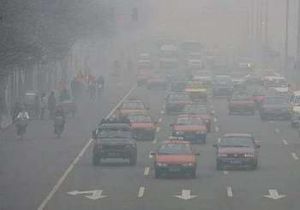Group 4: Kurtis, Franchesca, Youyou, Aisha, Andrew
Contents
Technology in Developing Countries
Introduction
Abstract
Is there a method of adopting and achieving cutting edge technology to the benefit of everyone in developing countries?
Apparently, there is, but it's road is both long and treacherous.
This is the core of T20G4's research and investigation into the technological developments within developing and recently developed countries. Focusing arbitarially on India and China, T20G4 took a look at the two countries and their people before and after the proliferation of computer technology. In the process, it became obvious that the criteria "for the benefit of everybody" was most convoluted and not always met, bridging social issues of economics, education, and environment; always, it was tied together through the actions - and lack of actions - taken by the government of each country on the issue. Just as obvious, though, was the fact that the issues were complex in each of their individual ways. As such, T20G4 distilled the basics from each, introducing their concepts as part of their investigation. It is with these basics and their relevance to each other that T20G4 understands and presents the possibility for a beneficial tech-transfer to a developing country, along with controversial and often dangerous possibilities related to each.
Inspiration
The idea to consider the influence of technology on other countries was an original idea stemming from a direct observation of previous technological issues projects. It was seen in previous works that many projects focused on issues that were extremely specific, and limited in their affect to mostly developed countries, where these issues emerged. So it was posed to the group: why follow in their footsteps and conduct a similarily narrow branch of research? Why not research instead the broad issue of technology itself, as it affects countries other than developed technological giants like the west?
Methodology
The group initially kept its branches of research broad, sifting through introductions to the arbitarially selected countries of China and India in an effort to compare their experience in technology. As specific issues and concepts materialized, the group intensified and narrowed research to expand their understanding of their knowledge of those areas, and also searched for links between the issues and concepts that tied their effects together. Though a substantial number of references were consulted, only the references from where specific quotations, ideas, figures and formulae were taken were formally recorded and listed along with this report.
The Government
As technology is adopted, it causes many social, education and environmental problems. Governments of developing countries play an essential role in helping its people enjoy and adopt the new technology while dealing with the side effects to society.
Chinese Government Involvement
The Chinese government is implementing plans to help its people adapt to new technology. For example there are “the medium and long-term plans” as well as “the five year plan” which was intended to follow up the general trend while making breakthroughs in major priorities. It has six major targets as follows:
Remarkable improvement of the industrial technical level and associated international
Breakthroughs in basic and strategic high tech studies
Provides S and T support for the coordinated development of population, resources and environment
Remarkable increase of the social input in S and T activities.
Constant flow of S and T personnel to meet development needs
Steady improvement of S and T infrastructures.
Indian Government Involvement
How much have computers touched the people in India? In 2002, in the Vardhaman district of West Bengal, the ruling CPI(M) government boasted about the modernization of its villages and the availability of computers in every rural school. That was not merely a claim; the schools were actually provided with computers. But the irony is that, in the district, which was declared the most literate district in India, the average level of literacy remains at writing one’s own name without even knowing the alphabet. While the government provided the area with computers, many of them remain unused without any objective.
Now, how can you use a computer without knowing how to read and write? Literacy is a major factor in adopting new technology and in India there is a lot of illiteracy where the government is implicit in the problem of not solving. Therefore if the Indian government had intervened and helped to solve the problem it would accelerate the process of adopting new technology. It is not the matter of technology but the matter of basic education and knowledge, and if the government cannot afford such plans they would outsource them to the private market.
Officially the most literate state, Kerala, in India launched a similar program. In Kerala, most of the students not only knew why they need to know computers, but their parent also has to understand the usefulness of learning computers. They have an objective to learn computers-to be more equipped so that they get good jobs.
Technology and Economic Inequality
Outsourcing tech transfers to companies and individuals – a common practice among developing countries strapped for investment into its technological infrastructure – is the equivalent of using a free-market solution to acquiring technology. That is, said companies and individuals are the sole deciders of which people receive which goods and services, and for what price. This leads to another problem - equity.
Measuring Wealth Disparity
Some have already suspected or speculated that not everyone in China or India have a similar standard of wealth. Guess what? They don't. In studies on wealth disparity, there are a number of analyzing methods in observing the magnitude of wealth disparity. Two types were used in Mr. Quan’s Structural Comparisons, one of the resources studied during research on wealth disparity: the more complex Gini coefficient, and the simpler gap ratio analysis.
The Gini coefficient, a statistical dispersion measurement used for income and wealth, which produces a value between 0 and 1 in correlating dispersion of income or wealth to the individuals of a population. In representative terms, 0 would mean every person/individual in the sample had the same income or wealth, with low numbers indicate that most people have relatively similar incomes and wealth. Contrasting this, high numbers indicate relatively erratic dispersion of wealth or income among individuals, with a practically impossible 1 indicating only one individual having all of the wealth or income, and everyone else having none. The exact details pertaining calculating and decomposing the Gini coefficient outside of this introduction are beyond the scope of this paper. More details can be found here [1]
The gap ratio analysis is simply a proportional rate between two wealth-related or income-related values of two comparable groups. With a single, unit-less value, it declares how much more wealth or disposable income is available to the richer of the two groups over the poorer. The inverse of the same value represents what portion of the richer group’s wealth or income the poorer group possesses. Commonly used values include per capita GDP for comparisons between regions, per capita Annual Disposable Income for comparisons between social groups, and per capita household consumption for when the spending habits can give an alternate picture of wealth inequality compared to income or wealth.
Income and Wealth Disparity
Having considered all this, we can now take a look at the values that Quan presents in Income Inequality in China and India: Structural Comparisons. According to Quan, inner urban Gini coefficients in 2001 were 0.3332 for China and 0.3500 for India nationwide – relatively high, given that the average developing or developed country has a Gini coefficient from 0.24 to 0.36. Inner rural inequality was not much better for China as Chinese rural Gini was 0.3633, though India’s Gini was a surprising 28.11. What is more important, though, is the overall income and consumption gap between urban and rural China and India; China’s gap ratio sat at 2.79 and 2.99 for income and consumption respectively in 2000, and India’s at 2.05 and 2.00 in the same period. For comparison, in Canada, the urban-rural gap ration in 1997 was 1.23, - or a Canadian 1997 urban family earned on average only 1.23 times more than the average Canadian rural family. In other words, in terms of urban-rural inequality, and, more likely than not, in terms of other forms of intra-national economic inequality, China and India display advanced characteristics of inequality.
Implications
What does this mean? Well, if you are going by a "buy it, use it" policy, then that means only those who can afford a new PC, IP subscriptions or a phone bill will benefit from computers, the internet, or cell phones.
To illustrate this problem, the Grey Global Group estimated that in 2005, approximately 50 to 60 million Chinese living in costal metropolises like Hong Kong, Shanghai, and Guangzhou, are responsible for the much-publicized boom in middle-upper class consumer spending – in particular, in consumer goods pertaining to “an American dream,” like automobiles, household appliances and electronics, and computerized goods and services. In contrast, the total population of China just the year before, in 2004, was almost 1.3 billion people; in other words, the people that make up the “New China” of digital business, culture, and society made up less than 4% of China’s total population. What about the rest? According to Mr. Quan, some of them are the 40 million farmers who have lost land to urbanization and become rural poor; hundreds of millions more make up migrating labour look for work in China’s growing infrastructure and production industries, putting them in a limbo between rural and urban classification. Both groups together not only represent a true majority of China’s population, but also have little in the way of opportunity to advance and become a market for technology short of direct government-initiated assistance.
And if less than 4% of a people can afford and benefit from the technology, well...it definitely isn't "to the benefit of everybody."
Technology and Educational Considerations
Knowledge has become the key driver of economic growth and international competitiveness. How to create, access and apply knowledge and technology is thus becoming the fundamental determinant of success. This makes education, skills and technologies more important.
Advantages for Education
Better technology leads to better education, which creates more scientists and engineers. This indicates the better usage of human resources, which leads to the quicker developments of China and India.
China has dramatically increased spending on classroom technology, because there has been a widely held belief by governmental, business and educational leaders that "wiring schools, buying hardware and software, and distributing the equipment throughout will lead to abundant classroom use by teachers and students and improved teaching and learning." 1980-2000, the enrolment ration for secondary education in China increased from 46% to 68%; tertiary from 2% -13%, around 15% recently (Zhang, 2003).2001, Indian national literacy rate has increased to be around 64.84%. This is due to the several major announcements that have been made by the Indian government in order to increase spending on education in India. The announcements are:
To progressively increase expenditure on education to around 6 percent of GDP.
To support this increase in expenditure on education by impositing an education cess over all central government taxes.
To ensure that no one is denied of education due to economic backwardness and poverty.
To make right to education a fundamental right for all children in the age group 6–14 years (Bhojani, 2008).
Disadvantages and Problems
Technology Handicap
Many people warn of the possible harmful effects of using technology in the classroom. They argue that students may lose their ability to relate to other human beings. They may become dependent on technology to learn too much. Most importantly, they may find inappropriate materials. But technology, such as the Internet, has given students unbounded access to information which can be turned into knowledge. Appropriately used— interactively and with guidance—it has become tools for the development of higher order thinking skills.
Brain Drain
People with good knowledge may immigrate to the more developed countries due to political instability or lack of opportunity, which is called a brain drain. An increasing number of the country's brightest minds are relocating to wealthier nations, where they can usually benefit from higher living standards, and brighter career opportunities.
China suffers the worst brain drain in the world, according to a new study that found by Hatung, D. stated that seven out of every 10 students who enrol in an overseas university never return to live in China. The Chinese Academy of Social Sciences revealed 1.06 million Chinese had gone to study overseas since 1978, but only 275,000 had returned. The rest had taken postgraduate courses, found work, got married or changed citizenship (Hatung, 2008).
In India, when students complete their education, they often leave for foreign countries in search of better working environment and pay package.
Inequality
Higher level of educational technology results in more expensive tuition fees, which leads to inequality. People who live in China’s urban and developed areas can access to more developed technology.
Government Involvement: DEPRS

There is an initiative that the Chinese government set up between 2003 and 2007 called the Distance Education Project for Rural Schools. The project set out to improve basic education in the rural areas of china, more specifically the poorer western provinces.
Considered the largest ICT project in the world, the DEPRS uses distance education which has been regarded internationally as a viable option for educating to help promote rural development.
Although the DEPRS project has already seen success as measured by university and school educators, it faces many problems and challenges.
Shortage of funding
The project currently only has 12B$ allocated to it which is seen has less than 1/3 the amount of money needed. However, the central government has stated that it will not accept responsibility for any more costs, so various levels of local government must explore and establish an effective mechanism to guarantee that the project operates properly. At the same time, local governments aren't allowed to levy additional taxes on the rural people, leaving future funding in limbo.
Insufficient learning materials
At this stage, the distance learning materials primarily consist of video recordings and TV programs of exemplary lectures delivered by experienced teachers, learning activities taking place in urban schools, and sample examination questions. These tools are invaluable considering the girth of instructional materials and teachers in rural areas, but they may not be completely suited to the needs of village students, especially those of minority ethnic groups.
Technology and the Environment
China and India - two of the world’s largest and historically acclaimed countries - are playing catch-up to the technologically developed. With their remarkable ability to adapt and grow, they are now seen as competitive markets for the West. If the West is struggling with being “green” and saving resources, China and India are being pressured to do the same. However the two named are going through their industrial revolutions now. It is inevitable then for these countries to be experiencing levels of environmental degradation. It can be argued; however, that if the developed countries served as models for the industrial revolution then they can also be models of environmental preservation.
Energy Production
In China the increase in technology has created an unconstrained expansion of energy-intensive industries, which in turn has caused China to become more dependent on imported oil and dirty coal. When developed countries are already experience a shortage in oil, not only will the oil cost China a lot of money but oil is not reusable. Dirty coal is a much cheaper alternative, but it’s detrimental for not only the environment but the citizens in China. In 2003 it was estimated by the Chinese Academy of Environmental Planning, that 300,000 people die due to air pollution annually. This number has grown because of the continuation of environmental degradation for the sake of technology, adding on to this in 2006 China surpassed Japan as the world’s number one producer of cars and trucks. Ever since the Beijing Olympics the pressure to eliminate greenhouse gas emissions in China has increased.One can argue that the governments do not care about the environment but rather they are looking for cheap and fast ways to develop. China for instance, does not have an Energy Ministry. Instead it has The Energy Bureau of the National Development and Reform Commission, with only 100 full time staff, while the US’s Energy Department has 110,000 employees. This doesn’t mean that China is recklessly destroying the environment. Despite having an Energy Department, in 2004, Americans on average produced 20.6 metric tons of CO2 VS, while the Chinese only produced 3.8. The Chinese government is looking for alternative sources of energy and is willing to try different technologies to save resources and protect the environment. They have two conditions to allow them to do this. The first being, China cannot cut back emissions until the U.S does as long with other developed nations because China produces goods for these countries. The second, that developed countries must be willing to provide China with the resources to create its own emissions cutting technology, because China is still developing and does not have available funds.
Urbanization
China is facing the same problems with the increase of urbanization. Ever since 2007, the Chinese government has been planning to urbanize half of its population. Just like India, this will lead to increased energy consumption and environmental degradation. The Chinese government is taking a different approach to these problems compared to India’s government. Since 2007 10% of China’s energy must be from renewable energy sources, solar energy is being looked at for residential buildings under12 floors. The US-based Natural Resources Defense Council (NRDC) has helped to build the first Leadership in Energy and Environmental Design building (LEED). It is 10 stories tall and uses 70% less energy than buildings of the same size, It also saved 10 000 tons of water annually through rainwater collection.
Slower Indian Development
India started to develop after China and the development has not been as rapid. It still faces the same problems as China when looking at environmental degradation, even though it is a “younger” developing country it is already trying to save resources and protect the environment. The government itself is not taking any major steps to reduce environmental damage in India. India deals with major environmental problems such as deforestation, coil erosion, overgrazing and water pollution. These problems affect the rural areas to a great extent. The government is not as concerned with the rural as it is with the urban developed parts of India. Still companies like Sitra and Waste Technology Associates are stepping up to try to protect India’s environment. Until India’s government is pushed by other nations, the way China’s was, it isn’t going to care about the environment. India has even less money than China, so they will need greater financial and technological support from the developed countries.
Conclusion
Having now considered India and China when it comes to technology, we say that there are a lot of difficulties in adopting new technology for everyone's benefit, and central to both the problems and their solutions is the very behavior and actions of the country's government. But if the bureaucratic paralysis were to be overcome and the government would choose to change their ways and deal with the problems at hand by increasing funding for the social, educational, and environmental spectrums then the difficulties associated to the above issues could more easily be avoided; therefore if the government shaped up cutting edge technology could be adopted for the benefit of everyone in developing countries
References
The Ministry of Science and Technology, People's Republic of China: CHINA SCIENCE AND TECHNOLOGY 2001-18
Zhu Zuoyan and Gong Xu: Basic Research: Its Impact on China's Future
Anurag: Impact of Computers and Technology
Heng Quan: Income Inequality in China and India: Structural Comparisons
The World Bank: Poverty Analysis – Measuring Inequality
The World Bank: Technical Note: Inequality Measures and Their Decompositions
Raymond Pong: Rural Poverty and Health: What Do We Know?
Pete Engardio: Crouching Tigers, Hidden Dragons
Pete Engardio: A Thousand Chinese Desires Bloom
N Bhojani: Business Week: China and India: A visual Overview (5 vols.)
D Hatung: Business Week: China and India: A visual Overview (8 vols.)
Chris Buckley: China wants Bali talks to back Technology Funds
Joseph Kahn and Jim Yardley: Chocking on Growth
Elizabeth Economy: China VS. Earth



